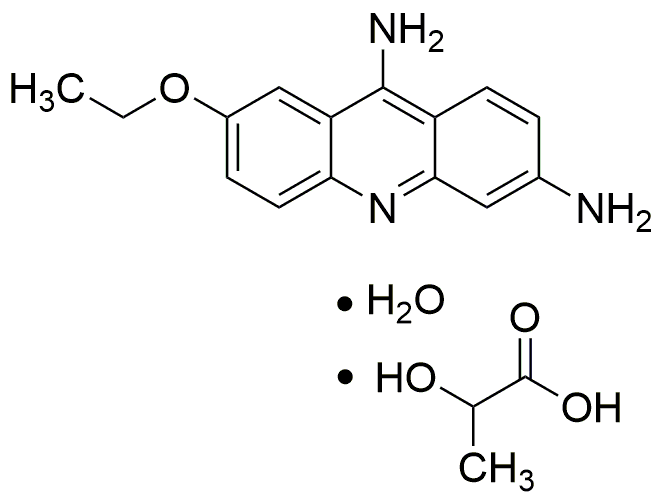Acrinol monohydrate is widely utilized in research focused on:
- Antimicrobial Applications: This compound is effective against various bacteria and fungi, making it valuable in developing antiseptics and disinfectants for healthcare settings.
- Pharmaceutical Formulations: Its properties allow for incorporation into drug formulations, enhancing the solubility and bioavailability of active pharmaceutical ingredients.
- Biological Research: Acrinol monohydrate serves as a fluorescent probe in cellular studies, aiding researchers in visualizing cellular processes and interactions.
- Textile Industry: It is used in dyeing processes due to its ability to bind with fibers, providing vibrant colors and improving fabric durability.
- Environmental Applications: The compound is explored for its potential in wastewater treatment, where it helps in the removal of pollutants and enhances water quality.
General Information
Properties
Safety and Regulations
Applications
Acrinol monohydrate is widely utilized in research focused on:
- Antimicrobial Applications: This compound is effective against various bacteria and fungi, making it valuable in developing antiseptics and disinfectants for healthcare settings.
- Pharmaceutical Formulations: Its properties allow for incorporation into drug formulations, enhancing the solubility and bioavailability of active pharmaceutical ingredients.
- Biological Research: Acrinol monohydrate serves as a fluorescent probe in cellular studies, aiding researchers in visualizing cellular processes and interactions.
- Textile Industry: It is used in dyeing processes due to its ability to bind with fibers, providing vibrant colors and improving fabric durability.
- Environmental Applications: The compound is explored for its potential in wastewater treatment, where it helps in the removal of pollutants and enhances water quality.
Documents
Safety Data Sheets (SDS)
The SDS provides comprehensive safety information on handling, storage, and disposal of the product.
Product Specification (PS)
The PS provides a comprehensive breakdown of the product’s properties, including chemical composition, physical state, purity, and storage requirements. It also details acceptable quality ranges and the product's intended applications.
Certificates of Analysis (COA)
Search for Certificates of Analysis (COA) by entering the products Lot Number. Lot and Batch Numbers can be found on a product’s label following the words ‘Lot’ or ‘Batch’.
*Catalog Number
*Lot Number
Certificates Of Origin (COO)
This COO confirms the country where the product was manufactured, and also details the materials and components used in it and whether it is derived from natural, synthetic, or other specific sources. This certificate may be required for customs, trade, and regulatory compliance.
*Catalog Number
*Lot Number
Safety Data Sheets (SDS)
The SDS provides comprehensive safety information on handling, storage, and disposal of the product.
DownloadProduct Specification (PS)
The PS provides a comprehensive breakdown of the product’s properties, including chemical composition, physical state, purity, and storage requirements. It also details acceptable quality ranges and the product's intended applications.
DownloadCertificates of Analysis (COA)
Search for Certificates of Analysis (COA) by entering the products Lot Number. Lot and Batch Numbers can be found on a product’s label following the words ‘Lot’ or ‘Batch’.
*Catalog Number
*Lot Number
Certificates Of Origin (COO)
This COO confirms the country where the product was manufactured, and also details the materials and components used in it and whether it is derived from natural, synthetic, or other specific sources. This certificate may be required for customs, trade, and regulatory compliance.


